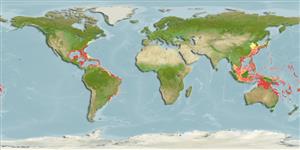Environment: milieu / climate zone / depth range / distribution range
Ekologi
laut berasosiasi dengan karang; kisaran kedalaman 1 - 110 m (Ref. 26938), usually 10 - 50 m (Ref. 5217). Tropical; 22°C - 28°C (Ref. 130653); 41°N - 33°S
Western Atlantic: Canada (Ref. 5951) to New York (USA), Bermuda, and northern Gulf of Mexico to southern Brazil.
Size / Weight / umur
Maturity: Lm ? range ? - ? cm
Max length : 18.0 cm TL jantan/; (Ref. 26340); common length : 12.0 cm TL jantan/; (Ref. 5217); Berat maksimum terpublikasi: 75.80 g (Ref. 131022)
Duri punggung (Keseluruhan (total)) : 0; duri punggung lunak (Keseluruhan (total)) : 76 - 91; Duri dubur: 0; Sirip dubur lunak: 58 - 69. Light tan to light gray with irregular pale rings or rosettes, some of which are dark-edged; scattered small dark spots and three large blackish spots along straight portion of lateral line, the middle one the best defined (Ref. 13442).
Inhabits sandy areas with coral rubble or seagrasses, usually near patch reefs (Ref. 9710). Shallow coastal waters to depths of 110 m (Ref. 26938). Lies motionless on the bottom, moving only when frightened (Ref. 9710). Larvae are attracted to lights at night but are difficult to see because they are transparent (Ref. 26938). About one-third of the diet consists of fishes; the rest of its food is crustaceans: crabs, shrimps, amphipods, and mantis shrimps (Ref. 13442).
Life cycle and mating behavior
Kematangan | Reproduksi, perkembang biakan | Pemijahan | telur-telur | Fecundity | Larva
Robins, C.R. and G.C. Ray, 1986. A field guide to Atlantic coast fishes of North America. Houghton Mifflin Company, Boston, U.S.A. 354 p. (Ref. 7251)
Status IUCN Red List (Ref. 130435: Version 2024-1)
ancaman kepada manusia
Harmless
penggunaan manusia
Perikanan: nilai komersial kecil; Akuarium: Komersial
Alat, peralatan
laporan khas
muat turun XML
Sumber internet
Estimates based on models
Preferred temperature (Ref.
123201): 21.8 - 28.9, mean 27.3 °C (based on 1916 cells).
Phylogenetic diversity index (Ref.
82804): PD
50 = 0.5000 [Uniqueness, from 0.5 = low to 2.0 = high].
Bayesian length-weight: a=0.01023 (0.00598 - 0.01751), b=2.92 (2.78 - 3.06), in cm total length, based on LWR estimates for this species & Genus-body shape (Ref.
93245).
Trophic level (Ref.
69278): 3.8 ±0.4 se; based on diet studies.
Daya lenting (Ref.
120179): sedang, Waktu penggandaan populasi minimum 1.4 - 4.4 tahun (Preliminary K or Fecundity.).
Fishing Vulnerability (Ref.
59153): Low vulnerability (10 of 100).
Nutrients (Ref.
124155): Calcium = 69.1 [27.1, 143.8] mg/100g; Iron = 0.55 [0.25, 0.99] mg/100g; Protein = 18.2 [16.6, 19.7] %; Omega3 = 0.0959 [, ] g/100g; Selenium = 31.4 [15.8, 67.5] μg/100g; VitaminA = 93 [24, 391] μg/100g; Zinc = 1.11 [0.73, 1.64] mg/100g (wet weight);
